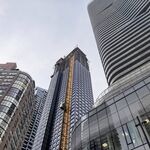With new neighbours on the way, promoters' sleepless nights may soon be distant memory
Jun 23, 2007 04:30 AM
Tracy Hanes
Toronto Star
When the partners in Cityscape Developments used to describe their plan to turn an abandoned five-hectare Toronto industrial site with decaying century-old buildings into a vibrant cultural mecca, they were often greeted with skepticism.
"I remember one prominent Toronto restaurateur looked around and said, `Call me back in 10 years when you get your first tenant,'" recalls John Berman, a lawyer, who along with real estate broker Mathew Rosenblatt, planner David Jackson and architect James Goad, is a partner in Cityscape.
He takes a certain satisfaction that some time later that same restaurateur called back – but there was no space available.
Since 2001, when Cityscape bought the 45 vacant buildings and property of the Gooderham & Worts distillery (between Parliament and Cherry Sts., south of Mill St.) for $10 million from its British owners, the Distillery District's 325,000 square feet of commercial space has been leased – for coffee shops, restaurants, bakeries, cafes, art and photography galleries, jewellery, fashion and home decor shops, artists' studios, offices and a spa.
It's also home to the Young Centre for the Performing Arts, as well as dance, theatre and opera companies and the site of music and arts festivals and other events.
But the evolution from an abandoned factory site to hip neighbourhood hasn't been easy. As the largest historic restoration project in Canada, at one point 300 woodworkers were employed to replicate original window frames, doors and trimwork, and 600,000 bricks were hauled from Cleveland to lend authenticity to the pedestrian-only streets. That initial $10 million investment has grown to $50 million-plus.
There have also been periods when businesses, disappointed by a lack of pedestrian traffic, fled for other parts of town. But with all commercial space accounted for and new developments in the works, an increase in year-round opportunities is virtually certain.
"It was a huge, huge risk we all took and there were a lot of sleepless nights," Berman says. "There still are challenges – we just had to rush in to rebuild a 150-year-old chimney last week."
Now, Cityscape and Dundee Realty, its partner in the project since 2004, are about to launch their second residential project in the Distillery District: Clear Spirit condominiums. [GRAPHIC]
Their first project, Pure Spirit, is under construction, with buyers scheduled to move in next spring.
Units in Clear Spirit will go on sale later this month. Plans call for a second Clear Spirit tower to be launched in the fall of 2008, as well as the Ribbon Building, a commercial/retail space linked underground to both Clear Spirit towers that will add several hundred underground public parking spaces.
The first 351-unit Clear Spirit tower, to be built to LEED (Leadership in Energy and Environmental Design) standards and designed by architectsAlliance, will be steel and glass, curving like a piece of fabric. Units are priced from $225,000 to $1 million-plus and range from 524 to 1,100 square feet. The entranceway and lobby, designed by Ava Janikowski, will echo the modern urban feel, integrating wood cladding from the distillery's historic rack houses, with spiralled columns and reflecting pools.
"The Distillery District is certainly one of the most wonderful places in Toronto," says Pam McConnell, city councillor for Ward 28, Toronto Centre-Rosedale.
McConnell says looking at the outside of the historic buildings now, it's hard to tell how difficult it was to restore some of them, as they were built to accommodate distilling, not residences or commercial space. For example, one had floors that were only 1.5 metres tall; and the buildings that housed the barrels and racks used the barrels as part of their structural support, McConnell says.
"For them to put their necks out and put money into heritage before building out the condos is unheard of. They did the right thing first. It was incredibly creative and visionary, but also practical – they got things done."
There's also a long way to go. While the area is very much downtown, many would-be visitors still see the district as off the beaten path, not a convenient destination.
It's served by the King streetcar and bus routes that connect it with the TTC's Union and Castle Frank stations, but outside rush hour (and especially between September and April) transit is not very attractive.
There are 450 commercial parking spaces on site and the Toronto Parking Authority has created 200-300 more along Parliament St., but finding a spot can be tough when events are on, especially since construction hoardings went up around the West Donlands sites east of Cherry St.
But McConnell says that once the West Donlands and East Bayfront areas are developed the Distillery District will not be "an isolated island of history and culture, but connected to two other neighbourhoods."
Syd Beder, owner of Lileo, a clothing store, says attracting patrons to the area was difficult for a while, "but I think the worst is over. They (Cityscape and Dundee) are being more proactive."
Beder says the parking problem has been relieved significantly by the addition of new lots and by inexpensive valet parking offered during special events and he's noticed an increase in visitors to the area in the past few months.
The ongoing construction has also hampered business somewhat, Beder says. "Short term, it was painful, but in the long term, I think it will be in our best interest and I'm still looking forward to a bright future," he says.
Like Pure Spirit, Clear Spirit will be contemporary in style, in contrast to the historic neighbourhood around it.
"The idea is to contrast the heritage buildings with new materials designed for today's culture," Rosenblatt says. "We want to speak to our time, not 150 years ago. So we're using modern materials and going for a minimalist look with glass and concrete."
Jason Lester of Dundee Realty says the look will suggest the city's historic Flat Iron Building (also built by the Gooderhams), juxtaposed against the background of modern BCE Place.
Unlike most mixed-use developments, the retail and commercial sector of the Distillery District came first, with the residential units coming later.
"It was easier for us to sell the residential component once we had a much more vibrant community," says Berman. "It made more sense to create a fantastic neighbourhood first."
"If you have a golf community or a ski community, you build the golf course and the ski hills first," says Lester.
Rosenblatt says attracting condo buyers to the previously stark industrial site without establishing the commercial and retail components first would not have been easy, especially as the "area was outside the average person's consciousness and most people didn't travel to this part of the city."
Because the property was a historic site, all work on it had to be approved by the city and Heritage Toronto. Then there was the matter of updating services and the structures themselves.
Cityscape, formed in 1997, has had experience with historic loft conversions and restorations, such as One Columbus Ave., the Movie House (394 Euclid Ave.) and Worx (436 Wellington St. W.).
Dundee Realty has worked on many projects in Western Canada, including golf and ski communities as well as large suburban developments.
"It's not any one thing that makes the Distillery – it's a bunch of pieces," says Rosenblatt. "It attracts like-minded people looking for something different. People who never even thought of living in the city before come to our sales office."
Whereas artists have often left communities when upscale condos come in, Rosenblatt predicts that won't happen in the Distillery District.
"We view the artists and arts component as part of the overall success of the Distillery District. To replace them and gentrify the area would not be successful," he says.
Many of the arts tenants have long-term leases, with below-market rates, to make it attractive for them to stay.
The plan for the District unfurled at a far quicker pace than the partners could have imagined – the original eight- to 10-year plan came together in half that time. Part of it was that some tenants – like Balzac's Coffee and the Sandra Ainsley Gallery – bought into the vision from the start and took a leap of faith that the public would come to the area.
Balzac's owner, Diana Olsen, didn't hesitate when Rosenblatt approached her.
"I used to live in Cabbagetown and jogged by there all the time. I loved those old buildings and saw they had so much potential," says Olsen. "By the time they called me and asked me if I'd heard of the Gooderham & Worts Distillery, I was totally familiar with it and just so excited. I had a gut feeling it would work. I was willing to take a chance even if it didn't."
A lineup of customers (including many of the project's construction workers) greeted Olsen the first day of business "and it's been going strong ever since."
The number of artists and arts organizations in the District brings a lively, creative energy to the neighbourhood, Olsen says, and about the only missing components are services like a dry cleaner and a grocery store. But she feels those will come as condos are built and the West Donlands property to the east is developed.
The Cityscape partners have their offices in the heart of the district, and there's still a firm rule that the retailers and restaurants locating there must be unique; don't, for example, expect to find a Starbucks or Gap there any time soon, as Berman says they are not interested in having large franchises there.
Berman says about 2 million people a year visit the district to wander through the shops and relax on the European-style piazzas.
"It's a fun place, it's a unique place. The closest thing to it is Granville Island in Vancouver. The key is to stick to the vision, plant the right seeds."




